Laptop Mag Verdict
HP adds a 3D display and glasses to an already powerful and stylish big-screen notebook.
Pros
- +
Bright, crisp screen
- +
Good 3D performance
- +
Stylish design
- +
Comfortable, backlit keyboard
- +
Strong graphics performance
- +
Great sound quality
Cons
- -
Very short battery life
- -
Parts of notebook get quite hot
- -
Too many steps to start 3D games
- -
Can't play 3D content on TVs
Why you can trust Laptop Mag
Go big or go home. That's the mantra of the HP Envy 17 3D. This large but stylish desktop replacement features an Intel Core i7 processor, powerful ATI graphics, a 3D-capable, full HD display, and a Blu-ray player. Starting at $1,599 ($1,649 as configured), the 3D version of the notebook costs the same as a similarly equipped non-3D version we reviewed just three months ago. Sounds like a sweet deal. But how does this machine stack up to laptops powered by Nvidia's 3D Vision technology? And is there enough 3D content to make donning those glasses worth the trouble? Our in-depth review reveals all.
Editor's Note: Portions of this review were taken from our earlier review of the HP Envy 17.
Design
The Envy 17 3D shares the same minimalist-chic design as the smaller Envy 14, including a rock-solid taupe chassis made of aluminum and magnesium. A few touches, such as a paisley-esque pattern of raised bumps on the lid and palm rest and HP's glowing logo on the lid, mark this as a premium laptop. Between the machine's durable feel and details such as quiet keys (more on that later), the Envy 17 3D feels like a luxury laptop.
At 7.5 pounds, the Envy 17 3D is a reasonable weight for a notebook this size, but you likely won't carry it often (and then, you'll need the AC adapter, as you'll see in the battery section). With a maximum height of 1.5 inches, the Envy 17 3D also feels thick, especially compared to Apple's 17-inch MacBook Pro, which is just 0.98 inches.
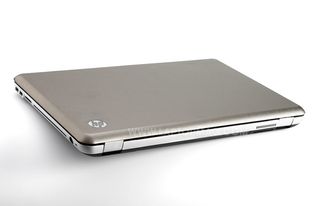
Click to enlarge
Keyboard and Touchpad
The Envy 17 3D has a chiclet-style keyboard and number pad that stretch across the 16-inch chassis. On the Ten Thumbs Typing Test, we typed at a fast rate of 94 words per minute, even with little practice on the keyboard. In addition to the keyboard's backlighting, we like that the keys have a soft finish and make little noise when you type. We also appreciate that you don't have to press the Fn key to access media controls in the function row of keys.
The Envy 17 3D has a large 4.2 x 2.5-inch touchpad which doubles as a clickable button. Although we've given HP's touchpads much flack in the past for being either jumpy or having too much friction, the Envy 17 3D's was easier to use. Occasionally, the cursor jumped slightly--it's worse for those who use two hands--but for the most part we had little problem moving the cursor to specific spots on the screen. The integrated touch buttons were always easy to press.
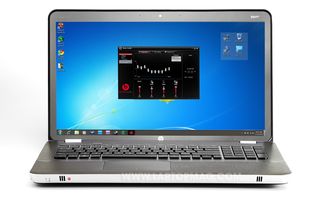
Click to enlarge
Heat
While the Envy 17 we reviewed in September stayed relatively cool, we noticed much warmer temperatures on the Envy 17 3D. After playing a Hulu video at full screen for 15 minutes, the touchpad stayed a chilly 84 degrees Fahrenheit, but the space between the G and H keys was a very warm 105 degrees, and the middle of the underside was 100 degrees.
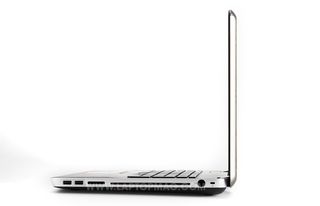
Click to enlarge
The left side of the Envy 17 3D is the real trouble area. We can accept a fan that blows 120-degree air. But after we played Call of Duty for 10 minutes, the left Shift and Caps Lock keys were a blazing 125 degrees. That's disturbing.
Display and Sound
For the non-3D version of the Envy 17, HP offers a BrightView Infinity display, which has a 1600 x 900 resolution, standard viewing angles, and a 60-percent color gamut. However, the 3D comes with a higher-res Ultra BrightView Infinity display, which has 1920 x 1080 full HD resolution, wide viewing angles, a 72-percent color gamut, and a refresh rate of 120Hz. The notebook also packs ATI's Eyefinity multi-display technology, which lets users connect up to three external monitors, provided one is attached via mini DisplayPort.
When we watched Blu-rays on the Envy 17 3D, we were impressed by the level of detail. As promised, the display was bright, too, and the colors were true. We were also able to watch movies comfortably from the sides and even with the lid pushed far forward, but that required us to dim the lights; with the lights on, the display was too reflective to watch at wide angles. We also wish HP included skip buttons on the keyboard; if you want to skip chapters in a DVD or Blu-ray, you have to use the touchpad and touch buttons.
The Envy 17 3D's speakers, which are tucked discreetly onto the front lip of the notebook, are powered by Beats audio technology. When listening to music or playing games, we were impressed with the fidelity and power of the speakers. Not only were sounds crisp and bright, but there was plenty of low-end bass, too. We liked that you can also tweak equalizer settings using the Beats audio control panel.
Ports and Webcam
The Envy 17 3D's ports include HDMI, VGA, mini DisplayPort output, and three USB ports (including one that doubles as an eSATA connector, and one that meets the new and faster USB 3.0 standard). Also included is an Ethernet jack, Kensington lock slot, and two headphone jacks, one of which doubles as a microphone connector. The notebook also has a 5-in-1 memory card reader.
The Envy 17 3D's TrueVision Webcam can record a max resolution of 1200 x 800. While details were crisp and movement fluid, images in fluorescent lighting took on a bluish tint, which we had trouble removing, even with the advanced settings in the MediaSmart Webcam software (where you can also add fun effects and avatars). Sound quality was excellent: Voices sounded natural, and the notebook's mics were strong enough to pick up on our conversations taking place off camera as well.
3D Experience
The HP Envy 17 3D uses ATI's active-shutter technology to display 3D content. That is, the notebook's display refreshes at 120Hz, twice the rate of most notebooks. A transmitter in the notebook then communicates with a pair of glasses, whose lenses flicker on and off to create a 3D effect. It's similar to the technology Nvidia uses, and far superior to the passive display technology (which uses simple polarized glasses) in systems such as the Lenovo IdeaPad Y560d.

Click to enlarge
The glasses weigh just 2.1 ounces and are comfortable to wear, even for those who already wear glasses. Unlike Nvidia's solution, the ATI glasses (created by a company called XPand) can't be recharged via USB--you have to replace a watch-sized battery--and there's no light telling you the glasses are on. An extra pair of glasses costs $99 through HP's site.
Transitioning from 2D to 3D viewing was fairly seamless. When the glasses flicked to life, the lenses got a little bit darker, but the screen never flickered, unlike the Acer Aspire 5745DG.
3D Gaming
In order to enable 3D on things such as games, you must open apps using the TriDef Ignition app. This is an extra step that's somewhat annoying; on Nvidia-powered 3D notebooks, programs that are 3D-compatible simply show up in 3D. Another annoyance is that, if you install games using Steam, TriDef Ignition won't recognize them automatically. You have to select the game from a drop-down list, then select the Steam EXE file, and then enter the app launch code for the game. That's way too many steps.
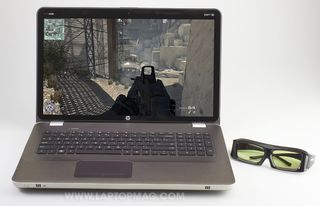
Click to enlarge
Once we actually started playing games, though, we found the experience to be enjoyable. Similar to Nvidia, ATI adds a laser sight in first-person shooters to help you aim. Even so, the added depth still takes some time to get used to. Like in real life, we found it easier to close one eye when looking through the scope of a rifle in Call of Duty 2.
Currently, TriDef 3D Ignition supports 351 games; that's about 150 less than what Nvidia supports. While both cover most of the popular games, neither supports FIFA 11 or NBA 2K11, which were both in the top 10 for U.S. retail sales in October 2010, according to NPD.
| Game | Tridef | Nvidia |
|---|---|---|
| Civilization | X | X |
| COD Black Ops | X | X |
| Dragon Age | X | Row 2 - Cell 2 |
| Fall Out: New Vegas | X | Row 3 - Cell 2 |
| rFactor | X | X |
| Sims 3 | X | X |
| Starcraft 2 | X | X |
| World of Warcraft | X | X |
The biggest problem facing widespread 3D adoption (whether it's notebooks or TVs) is the lack of content. TriDef's software on the Envy 17 3D attempts to get around this by converting 2D content into 3D. This not only includes photos and videos, but DVDs as well. After opening the TriDef Player, we popped a movie into the Envy 17 3D and enjoyed fairly decent visuals. While not as crisp and three-dimensional as movies shot in that format, the software did add some depth. Even better, you can tweak the amount of 3D-ness on the fly using two controls in the lower right-hand corner of the player.
Unfortunately, the TriDef software won't convert Blu-rays. However, 3D Blu-ray movies looked tremendous on the Envy 17 3D. Despite narration by Tom Cruise, the documentary IMAX Space Station 3D was fun to watch. Not only were visuals crisp and bright, but the 3D effect was spot-on. Of course, there's only 25 3D Blu-rays currently listed on Amazon.com, and of those seven are available for pre-order and three are unavailable.
We also liked that the TriDef Ignition software supports Google Earth (Nvidia says native support will be available by 2011). The Grand Canyon looks a lot grander when rendered in 3D; you really get the sense that you could dive into the screen and you'd be there. However, there's no way to quit Google Earth; we had to press F1 to bring up the help menu in order to exit the program.
One neat feature of Nvidia's newer graphics cards--such as can be found in the Dell XPS 15 and the Acer Aspire 5745DG--is that, when coupled with an HDMI 1.4 port, users can output 3D content, such as a Blu-ray, to a 3D-ready TV or projector. While relatively few people actually do this, it's a nice feature to have. Sadly, the Envy 17 3D has an older HDMI 1.3 port, so this isn't possible.
Performance
The Envy 17 3D comes armed with a quad-core 1.6-GHz Intel Core i7-720QM processor, 6GB of RAM, a 640GB, 7,200-rpm hard drive, and the 64-bit version of Windows 7 Home Premium. On paper, that's a better value than the 17-inch MacBook Pro, which starts at $2,299. The base model of that laptop has a Core i5, not a Core i7, processor, 4GB of RAM, a 500GB, 5,400-rpm hard drive, and has 512MB video memory, not the full gigabyte that the Envy 17 3D includes.
The Envy 17 3D's score of 5,888 on PCMark Vantage, a Windows benchmark, is about 300 points above the desktop replacement category average, but about 800 points below the 17-inch MacBook Pro. Its boot time of 64 seconds, too, is about even with the average. The 640GB, 7,200-rpm hard drive duplicated a 5GB folder at a rate of 28.3 MBps, a tad slower than the 32.4MBps rate that the older Envy 17 500GB drive turned in, not to mention the 31 MBps category average.
The notebook also transcoded a 114MB MP4 file to AVI in 60 seconds, using Oxelon Media Converter, which is 7 seconds faster than the category average. Everything felt fairly fast on the system.
Graphics
Thanks to a 1GB ATI Mobility Radeon HD 5850 GPU, the Envy 17 3D has plenty of graphics muscle. For starters, its score of 10,482 on 3DMark06 is about 2,900 points above average, and its score of 6,538 in 3DMark Vantage is about 300 points above average. However, the Asus G73Jw-A1, another 17-inch behemoth with a full HD screen, scored 7,438 on 3DMark Vantage, courtesy of its Nvidia GTX 460M graphics card.
In real-world gaming, the Envy 17 3D turned in above-average frame rates. For instance, in World of Warcraft, the laptop reached 47 frames per second at its native resolution. In the same game, the average desktop replacement averages 59 fps (and many of those machines don't have full HD displays). In Far Cry 2, a more graphically demanding game, the Envy 17 3D peaked at 41 fps at its native resolution, well above the desktop replacement average of 30 fps.
Although the Envy 17 3D has good gaming chops, it's no match for the ASUS G73jw-A1 ($1,749). That notebook peaked at 130 fps in World of Warcraft and managed 53 fps in Far Cry 2 at its native resolution.
Battery Life and Wi-Fi
The Envy 17 3D's biggest weakness? Battery life. This notebook lasted just 1 hour and 15 minutes on the LAPTOP Battery Test (continuous surfing over Wi-Fi); that's half the endurance a typical notebook of this size offers. Desktop replacements aren't exactly known for having long battery life (the average is 2:45), but it would be nice to be able to use the Envy 17 3D on the sofa, in the kitchen, or anywhere else unplugged for a longer period of time. The 17-inch MacBook Pro, for example, which has switchable graphics, lasted 7 hours and 54 minutes.
The Broadcom 802.11a/b/g/draft-N wireless radio inside the Envy 17 3D delivered faster-than-average throughput. The notebook delivered a data rate of 35.4 Mbps at 15 feet and 21.3 Mbps at 50 feet, whereas the average desktop replacement has wireless strength of 28.1 Mbps and 18.6 Mbps at these respective distances.
Configurations
Surprisingly, it's actually less expensive to get the Envy 17 3D used in our review than a similarly configured laptop without 3D. The non-3D Envy 17 starts at $1,299, but adding a 1.6-GHz Core i7-720QM processor, a 640GB, 7200-rpm hard drive, a 1080p Ultra BrightView Infinity LED Display, and a Blu-ray player brings the total cost to $1,749 on HP's site. Our 3D configuration with the same specs costs $1,649.
Have more dough to blow? HP's $2,059 recommended configuration of the Envy 17 includes the same 1.6GHz Core i7-720QM processor but steps up to 8GB of RAM and a 5,200-rpm 1TB drive. If you want to go whole hog, you can outfit the Envy 17 3D with a 1.86GHz Core i7-840QM processor ($400) and dual hard drives--a 640GB, 7200-rpm drive and a 160GB SSD ($260).
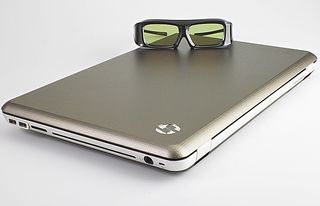
Click to enlarge
Software and Warranty
HP's bundled software includes some branded utilities, such as support and wireless assistants, as well as a MediaSmart suite that helps users organize and view photos, music, video, and images captured with the webcam.
Other pre-installed programs include Adobe Premiere Elements and Adobe Photoshop Elements, CyberLink DVD Suite and Power2Go, Roxio CinemaNow. Instead of annoying trialware, HP opted to go with Windows Live Essentials. We're not complaining.
The Envy 17 3D comes with a one-year warranty, including 24/7, toll-free phone support. To see how HP fared in our annual tech support showdown, click here.
Verdict
The Envy 17 3D is not cheap, but for $1,649 you get a premium design, quad-core power, solid gaming performance, Blu-ray, and a bright 1080p display. The 3D experience isn't as robust or as seamless as laptops powered by Nvidia's 3D Vision technology, but we like that the TriDef 3D software can convert 2D content on the fl, and supports many of the latest games. The only things we're not enamored with is the Envy 17 3D's short battery life and heat issues, which keep it from earning an Editor's Choice. If you're not that keen on 3D, you can pick up the Asus G73Jw-A1, a 17-incher that offers faster performance and better frame rates for about $50 to $100 more. Overall, though, the Envy 17 3D is a good-looking, fast, and fun 3D notebook.
HP Envy 17 3D Specs
| Bluetooth | Bluetooth 2.1+EDR |
| Brand | HP |
| CPU | 1.6-GHz Intel Core i7-720QM |
| Card Slots | 5-1 card reader |
| Company Website | www.hp.com |
| Display Size | 17.3 |
| Graphics Card | ATI Mobility Radeon HD 5850 |
| Hard Drive Size | 640GB |
| Hard Drive Speed | 7,200rpm |
| Hard Drive Type | SATA Hard Drive |
| Native Resolution | 1920x1080 |
| Operating System | MS Windows 7 Home Premium (64-bit) |
| Optical Drive | BD-ROM/DVDRW DL |
| Optical Drive Speed | 8X |
| Ports (excluding USB) | Kensington Lock, Headphone, eSATA/USB, HDMI, VGA, Ethernet, USB 3.0, Mini DisplayPort, Microphone |
| RAM | 6GB |
| RAM Upgradable to | 8GB |
| Size | 16.4 x 10.8 x 1.2-1.5 inches |
| Touchpad Size | 4.25 x 2.5 |
| USB Ports | 3 |
| Video Memory | 1GB |
| Warranty/Support | One-year limited/Toll-free, 24/7 phone support |
| Weight | 7.5 pounds |
| Wi-Fi | 802.11a/g/n |
| Wi-Fi Model | Intel Centrino 6200 AGN |
